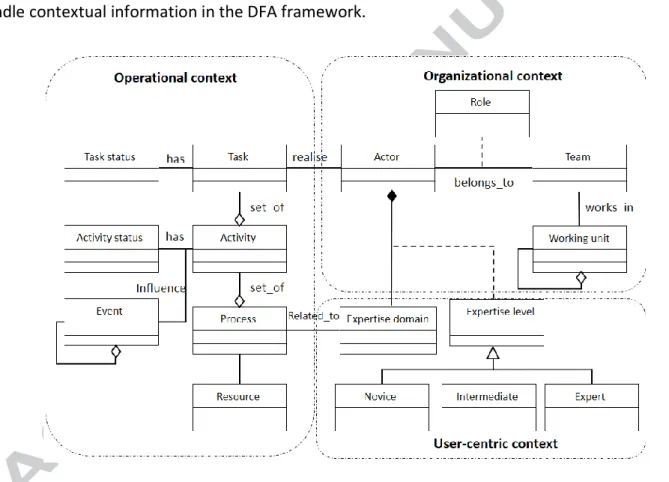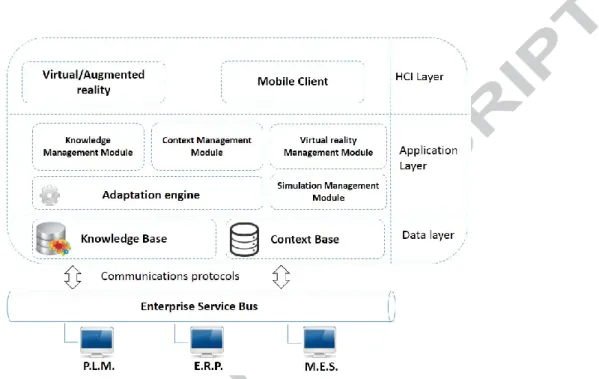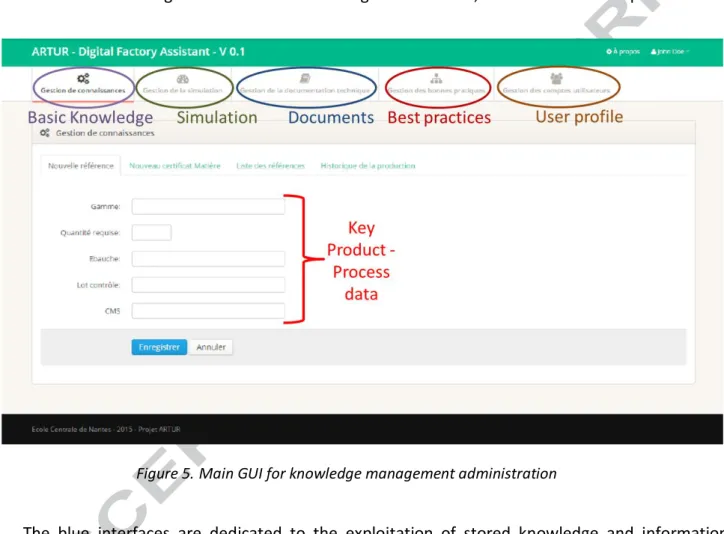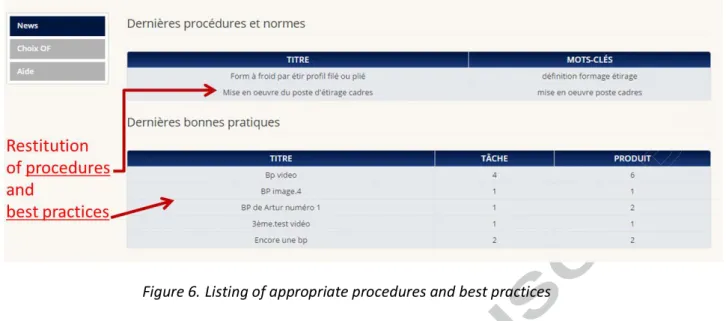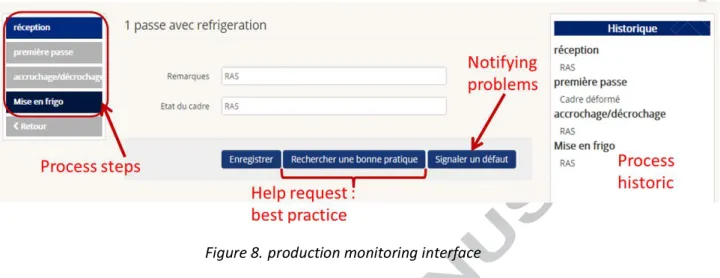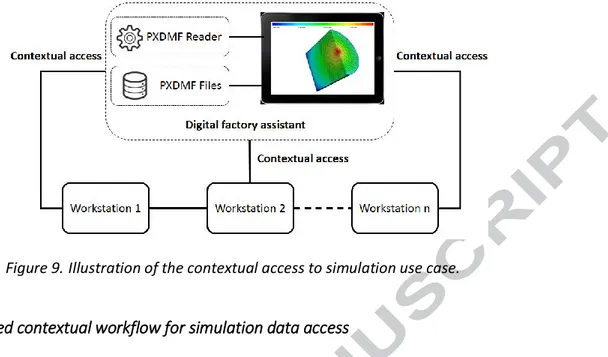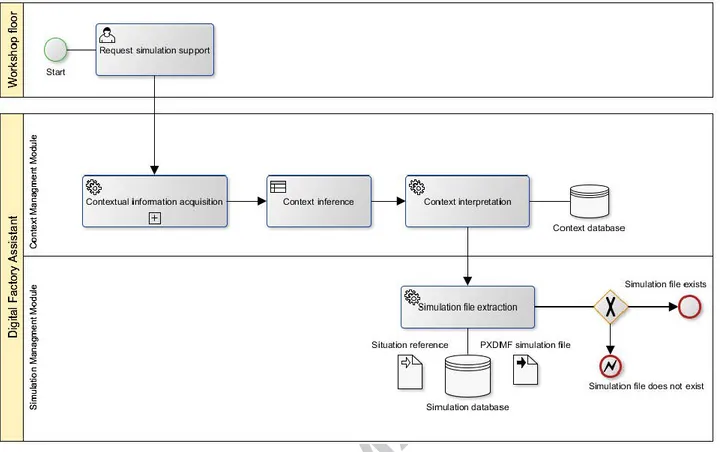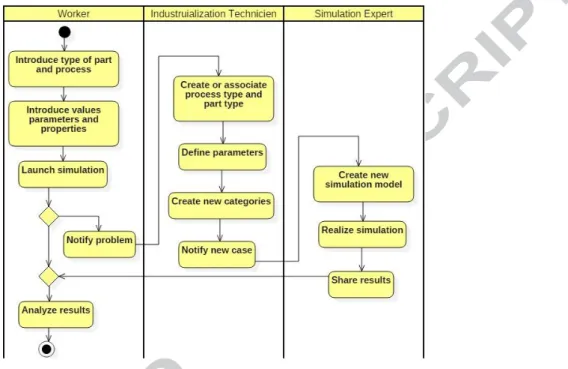HAL Id: hal-02277056
https://hal.archives-ouvertes.fr/hal-02277056
Submitted on 25 Oct 2019
HAL is a multi-disciplinary open access archive for the deposit and dissemination of sci-entific research documents, whether they are pub-lished or not. The documents may come from teaching and research institutions in France or abroad, or from public or private research centers.
L’archive ouverte pluridisciplinaire HAL, est destinée au dépôt et à la diffusion de documents scientifiques de niveau recherche, publiés ou non, émanant des établissements d’enseignement et de recherche français ou étrangers, des laboratoires publics ou privés.
Intelligent assistant system as a context-aware
decision-making support for the workers of the future
Farouk Belkadi, Mohamed Anis Dhuieb, José Vicente Aguado, Florent
Laroche, Alain Bernard, Francisco Chinesta
To cite this version:
Farouk Belkadi, Mohamed Anis Dhuieb, José Vicente Aguado, Florent Laroche, Alain Bernard, et al.. Intelligent assistant system as a context-aware decision-making support for the workers of the future. Computers & Industrial Engineering, Elsevier, 2019, pp.105732. �10.1016/j.cie.2019.02.046�. �hal-02277056�
Intelligent Assistant System as acontext-aware
decision-making support for theworkers of the future
Abstract
The key role of information and communication technologies (ICT) to improve manufacturing productivity
within the paradigm of factory of the future is often proved. These tools are used in a wide range of product
lifecycle activities, from the early design phase to product recycling. Generally, the assistance tools are mainly
dedicated to the management board and fewer initiatives focus on the operational needs of the worker at the
shop-floor level.
This paper proposes a context-aware knowledge-based system dedicated to support the actors of the
factory by the right information at the right time and in the appropriate format regarding their context of work
and level of expertise. Particularly, specific assistance functionalities are dedicated to the workers in charge of
the machine configuration and the realization of manufacturing operations. PGD-based (Proper Generalized
Decomposition) algorithms are used for real time simulation of industrial processes and machine
configuration. At the conceptual level, a semantic model is proposedas key enablersfor the structuration of the
knowledge-based system.
Keywords: Context-awareness, Decision-aid system, Factory of the future, Knowledge management, PGD,
1. Introduction
In their recent research review, Esmaeilian et al., [2016] highlights more than 40 technological, societal and informational pillars for the factory of the future. Among these elements, information and communication technologies and knowledge asset take a great interest in the new strategies and
Farouk Belkadi1*, Mohamed Anis Dhuieb2, José Vicente Aguado3, Florent Laroche1, Alain Bernard1, Francisco Chinesta3
1Laboratory of Digital Sciences of Nantes, LS2N – UMR CNRS 6004, Ecole Centrale de Nantes, France 2
3
PerioSystem, 92130 Issy-les-Moulineaux, Paris France
Research Institute of Civil Engineering and Mechanics, GeM – UMR CNRS 6183, Ecole Centrale Nantes, Nantes, France
offer high potential of innovation [Wu et al., 2017]. This is because human capital is the driving force for production efficiency and optimization [Mavrikios et al. 2011]. However, although their role is indisputable, the actors of the factory are capable of making mistakes that, no matter what their origin, have a direct influence on the cost of non-quality (CNQ) and delays [Schiffauerova et al., 2006]. Some studies have demonstrated that human-caused CNQ is due to three main reasons: lack of appropriate guidelines, gaps in training, and the unavailability of documentation in production lines [Benhabib et al., 2004]. Furthermore, the heterogeneity of data and information makes their integration and management very complex [Zhong et al. 2016]. Managers aiming to face today’s competitiveness are continuously seeking to help their employees to efficiently accomplish their jobs. This goalcould be achievedby promoting a human-centered visions and roadmaps as key pillars of the factory of the future (FoF)[Longo et al., 2017].
In this context, the concept of “Digital Factory Assistant” (DFA) is proposed under the ARTUR (in French: AtelieR du fuTUR, translated as shop-floor of the future in English) project as a framework for intensive knowledge reuse dedicated to assist factory workers in their daily activities. The aim is also to improve the operational process efficiency through a set of decision-making support for problem solving and reaction against various events and operational constraints.
Indeed, to deal with different working situations, actors have to be aware of important elements in the situation and to interpret it correctly according to their task of interest [Hasan et al., 2003]. Being constantly aware of all these elements is a difficult task for the workers and may lead to a cognitive overload. Based on contextual knowledge reuse, high-speed simulation and advanced visualization techniques, the aim of the DFA framework is to provide proactive support for different manufacturing tasks. As an extension of classical decisions support systems that mainly focus on the delivery of key indicators and risk notifications, the proposed framework aims to centralize the
knowledge asset in the factory and enables each actor to access the useful knowledge according to his/her working situation and real operational need. That said,the decision-making support built under the proposed framework will considerthe user’s profile by formatting the appropriate information in a consistent way so as to allow him well understanding and easier use of the available knowledge [Laroche et al., 2012; Dhuieb et al., 2013].
The remaining of the paper is organized as follow. Section 2 discusses the main innovations within the paradigm of factory of the future. A state-of-the-art of different knowledge based and decision-making support systems used in the manufacturing field is given. The choice of these systems was based on two main criteria: the application scope and the consideration of the concept of context as enabler of the systems. The motivations of the proposed intelligent assistant system are explained at the end of this section while the characteristics of this framework are detailed in section 4 from conceptual and technical points of view. Section 5 concentrates on the problem of multi-physics simulation as key assistance functionality proposed by the Framework. This aspect is illustrated through an implementation scenario allowing users to access contextually to the simulation models in real time condition. In section 6, the advantages and limits of the proposed system are discussed based on feedback from first application in industrial context and a comparison with some existing tools. Conclusion and perspectives of future developments are given at the end.
2. Motivations: Towards a new generation of assistant systems in factory
2.1. Visions of the factory of the future
Complementary visions contribute to the initiative of the factory of the future [Göleç, 2015]. According to [Westkämper, 2014], the factory of the future requires holistic production systems with learning capabilities integrated into the entire product lifecycle, from the design and initial configurations to after-sales services. In particular, the smart factory aims to enhance the control and
the optimization of factory processes based on advanced ICT tools [Lucke et al., 2008]. For instance, the vision for a smart factory developed in the work of [Zuehlke, 2010] aims to build the concept of the “Factory of Things” where the factory implements intelligent objects interacting together to exchange information about their states. This vision is inspired by the “Internet of Things” concept developed in computer science [Lee et al., 2017].
The German thoughts about the factory of the future are expressed in the concept of industry 4.0 [Kagermann et al, 2013]. This concept encloses technologies and industrial processes allowing all the physical and virtual actors of the production system to interact in the same environment. According to this vision, the next industrial revolution will be distinguished by the generalization of sensors and intelligent agents with the aim of communicating with other machines, products, processes, humans, etc. The main objectives are to rapidly detect any production variation, anticipate the dysfunction and accelerate the research for new solutions and alternatives.
The importance of giving more emphasis to the role of the human being as a key driver for better factory performance has been pointed out by many visions and roadmaps about the factory of the future. Mainly, [Westkämper, 2014] discussed the next human-centered production systems and how the human being will work jointly with digital objects in the factory. Knowledge engineering tools and methods are one of the key enablers supporting this issue [Quintana-Amate et al., 2017].
2.2. Emerging ICT trends for future manufacturing systems
The importance of information systems (IS) in industry has been highlighted from the last three decades and several propositions have been made along this period [Collins and Parks 1991]. In Toro et al. [2007] for example, a framework were developed for the exploitation of embedded knowledge in industrial maintenance. The proposed framework is based on a shared ontology designed to model and support pervasive computing applications called SOUPA (Standard Ontology for Ubiquitous and
Pervasive Applications). The UDKE (User, Device, Knowledge and Experience) is a conceptual model of the maintenance support tool that combines knowledge, user experience and Augmented Reality techniques. Even though the system relies on SOUPA ontology known by its ability to handle contextual information, nothing is mentioned in this work about handling different situations that a maintenance agent may encounter in real life. In another study, decision support system architecture was proposed by [Klein et al., 2008] in order to improve product flow control. The novelty in their work was to continuously feed the decision support system by Kanban cards that provide additional shop-floor information. The aim was to give the decision-maker a consistent view of the shop-floor. While in [Kong et al., 2000], an intelligent decision support system was developed to support the task allocation and reallocation, local queue management and production resource management in the metal forming process.
The CARMMI framework outlined in the work of [Espindola et al., 2013] provides a support to operators during maintenance tasks through mixed reality. The presented framework allows the acquisition and presentation of different CAx data with the aim of predicting breakdowns that may occur in industrial equipment. Kwon et al., [2004] has developed a framework called ubiDSS. ubiDSS is a framework of multi-agent and context-aware-based proactive decision support system. The architecture of this framework is composed of a number of subsystems: context subsystem, dialogue subsystem, knowledge subsystem, model management subsystem, and a database management subsystem. Even though the application field of the ubiDSS system is not applied in the manufacturing domain, it gives very interesting lessons on the interactions between the components of such a framework.
Recently, the new generation of IS embeds intelligence and communication features to provide assistance tailored to specific business process such as for maintenance and machine configuration
[Ruschel et al., 2017]. As explained by [Satyanarayanan, 2001], our Society has moved progressively from a Distributed System to pervasive and ambient computing [Syvanen, 2005]. The first two states have been observed but the last and third one is coming [Cliquet, 2010] (see Figure 1).
Distributed systems allow remote communication and access to shared information inside wide networks while preserving security and data availability issues via encryption, authentication and backup technologies. Mobile systems propose advance communication facilities that ensure continuity of services independent from geographical location. To enhance their efficiency, these tools are based on limited resources and offer summarized interfaces to be adapted to various environments. Ubiquitous systems are the category of systems that take in consideration the context of user through some measurements and personalization of profile [Lyytinen et al., 2002]. This concept is introduced in 1991 by Weiser [Weiser, 1991] to describe a computer vision which provides assistance without anyone noticing its presence. Additional technologies like virtual and augmented reality [Nee et al., 2012] are now an emerging field in industry and contribute to its evolution. The aim is to enhance the real life sensation of the user when interacting with the decision system.
Figure 1. From distributed systems to ubiquitous systems:everyday life VS factory.
To sum up, many systems and frameworks applied to different working environments in the factory were found. Most of the research works are oriented towards specific applications. Except for
[Kong et al., 2000], fewer research works has tried to assist factory stakeholders at machine level where the information is less available but essential in the achievement of manufacturing tasks. Looking to the actual maturity on the usage of information and communication technologies, even in the “ordinary life”, it is assumed that the factory of the future must follow this tendency and demonstrate a great implication on the adoption of such technologies.
2.3. Evolution of Decision Support Systems
Decision Support Systems (DSS) are kind of information systems provided with a high capability of reasoning to provide their users with a set of appropriate information [Schönberger et al., 2011]. In [Shim et al., 2002], DSS are defined as “a set of computer technology solutions that can be used to support complex decision making and problem solving”. Even though multiple definitions of DSS can be found in literature, they share a common vision: DSS attempt to automate several tasks of the decision making process [Büyüközkan et al., 2011] in order to provide users with a set of possible solutions regarding his/her problem. In final, the decision is selected, accepted or modified or refused by the Human.
Since their appearance, DSS has evolved in a significant way thanks to the side-by-side evolution made in information and communication technologies. This evolution has resulted in the appearance of a web-based technologies [Boreisha et al., 2008], Mobile solutions [Wen et al., 2008], and the ubiquitous DSS [Kwon et al., 2005].Figure 2, illustrates the relation between the portability of the DSS and the network type used in the implementation. As we can see, types of DSS have moved from individual DSS to a new category of DSS,based on the ubiquitous computing vision,in which context awareness [Dhuieb et al., 2016, Carneiro et al., 2012] takes an important place in order to anticipate the user’s needs in a particular situation and act proactively to provide appropriate assistance.
Figure 2. Evolution of DSS: an Illustration based on [Kwon et al., 2005].
Context awareness provide a clearer understanding of the way experts integrate knowledge during problem solving, and thus provide common grounds for decision-making and knowledge sharing [Anya et al., 2012]. Thanks to these capacities, a context-aware decision support system utilizes contextual information in the problem solving process to provide personalized service with minimum of explicit interaction between human and computer [Chen and Chen 2010]. It provides people by accurate information on their environment and assists experts making plans and monitoring their daily activities [Fadzillah et al., 2013], [Ngai et al., 2011].
2.4. Synthesis
The main idea of ubiquitous computing based DSS is to apply the vision of Weiser [Weiser, 1991] with the aim of ensuring a higher level of information availability and proactivity. Embedding ubiquitous facilities can resolve the problem of user workload when manipulating several information systems and requiring real time assistance. However, even this concept is old, it is still an interesting scientific challenge that until now has not been sufficiently exploited by the industrial engineering research communities. Particularly, the usage of this kind of systems is limited because of the need of advanced technologies and the manipulation of large amount of data. Actually, recent developments
on big data collection and analysis as well as interoperability with information systems make the challenge reachable. This constitutes the first motivation of this research work: how a smart combination of recent technologies can contribute to the improvement of business processes? The second motivation is leaded by the application domain: industrial environment especially dedicated to the workers who generally are not familiar with such kind of applications and require more consideration of their level of expertise.
As a synthesis of the state of the art, the ubiquitous computing paradigm came with interesting concepts that the industrial community and the visions of the factory of the future can benefit from. Table 1 compares the proposed digital factory assistant with other systems and frameworks cited in the second section. The comparison is based on different points of view.
Situation perception: indicate if the system proposes some connections to sensors, information systems and other facilities to real time capturing of new events in the situation.
User assistance: through real time notifications and warnings or offline procedures and reports to prevent risks of task failure or security problems.
Collaboration facilities: indicates if the system is able to support information sharing and situation awareness as well as coordination rules.
MMI (Man Machine Interaction): or how the system support Knowledge restitution and presentation, which is a very important aspect that affect the efficiency of any DSS.
Contextual access: indicates if the system allows users accessing to content and functionalities based on their current objectives and status of their activities.
Legacy tools interoperability: does the system use some connections to legacy tools to extract knowledge, perform computing or realize some offline simulations.
Application domain: gives information about the genericity level of the solution depending on the variety of business domains.
Table1: Comparison between the DFA system and other DSS.
System / Framework Description Situation perception Real time assistance Collaboration facilities MMI Contextual access Legacy tools
connection Application domain CARMMI
[Espindola et al., 2013]
Intelligent system for breakdowns prediction and industrial machines monitoring.
Not supported Supported Not supported
Mixed reality Desktop interface Not supported Supported Industrial maintenance – Can be mapped to different domains UDKE [Toro et al. 2007] Knowledge based system for industrial maintenance
Considered but not implemented
Not
supported Not supported
Mobile interface Augmented reality
Supported Not
supported Industrial maintenance
UbiDSS [Kwon et al., 2004] Framework of ubiquitous decision support systems
Not supported Supported Not supported Mobile
interface Supported Supported
Product recommendation for customers – Can be mapped to different domains Simulation-based[Klein et al., 2008]
Decision support system
for product flow control Supported Supported Not supported Web interface Not
supported Supported Product flow control
[Kong et al., 2000]
Intelligent decision support system for metal forming industry
Supported Supported Not supported Not indicated Not
supported Supported Metal forming process
DFA ubiquitous
decision-making assistant system Supported Supported
Considered but not implemented Virtual/Augmen ted reality Mobile/desktop interface Supported Supported Manufacturing operations – Can be mapped to different domains
3. ARTUR Platform: Functional architecture and related foundations
Looking at the actual industrial problematics and considering the recommendations of the state of the art, this section aims to set up the key elements of the proposed decision making platform by representing the functional architecture and describing the main scientific foundations behind the proposed functions.
3.1. Functional architecture
Analyzing and managing requirements of heterogeneous stakeholders is a key step to guarantee successful software project [Violante et al., 2017]. The analysis of the current needs of the operational actors in a factory points out three fundamental requirements to be respected by the assistant system: the multi-scale knowledge structuring approach, the ubiquitous knowledge access and the real time assistance. The first feature is because the expertise level is different from one worker to another and it is needed to adapt the knowledge restitution according to the user profile. The second feature highlights the fact that efficient decision making assistant should take in consideration the problem to resolve but also the current working situation of the decider that can impact his actions. Finally, real time assistance because that the worker is at the operational level face to the machine and need to react rapidly to some events. Real time simulation is preferred for this topic. Other aspects related to the virtual engineering based assistance in the ARTUR project are beyond the scope of this paper. However, some illustrations on how virtual engineering tools can be linked to PLM systems through the DFA framework are explained in [Dhuieb et al., 2014].
The aim of the DFA system is to provide the worker at the production line by a set of useful information at the right moment when he//she is facing the machine. Concretely, the core functionalities are the followings:
Providing the right formal procedures for the configuration of the machine and the selection of the process parameters.
Capitalizing and sharing the best practices as applied usually by the experts when resolving some operational but redundant problems.
Real time simulation to assist the user analyzing the effect of different machine/process configurations on the form of the resulted product.
Knowledge transformation and adaptation for optimal restitution according to the level of expertise of the workers and his/her context of work.
That said, the development of these functionalities requires solid scientific foundations but pragmatics from an industrial point of view. The next sections describe this kernel aspect.
3.2. Multi-scale knowledge structuring approach
In this work, we propose an approach in order to structure the knowledge set into multiple scales as a conceptual foundations supporting efficient knowledge restitution. The idea of expertise breakdown into different levels can be found in the model of [Dreyfus, 2000] who proposes to organize the skills that anyone can acquire into five stages: novice, advanced beginner, competent, proficient and expert.
In this work, three knowledge restitution levels are distinguished. Each one translates a completeness level of an activity domain in the factory. With respect to the multi-scale structuring hypothesis, the knowledge base can be organized in three completeness levels: . It is intended to store and to formalize the same knowledge within different representation. The knowledge Ki is a triplet Ki=<Pi|Pri|Ri> where Pi, Priand Ri represent
respectively the knowledge set of the product, the process and the resources used. Therefore, a knowledge base that encompasses these knowledge fragments can be represented by the set KB =
{Ki, i € {1...n}}. This decomposition is inspired from models found in the literature mainly UEML
[Vernadat et al., 2002] and FBS PPRE [Labrousse et al., 2004]. The integration of knowledge into the ubiquitous decision-making assistant system is done by formalizing expert knowledge and by accessing to the existing information systems (ERP, PLM, MES, etc.). Thus, the foundation of the multi-scale structure is to reduce the information overload by giving the beginner, intermediate and expert workers only the appropriate amount of knowledge on the suitable format.
3.3. Ubiquitous knowledge access
In fact, managing access to factory knowledge base depends not only on the expertise level but also on multiple factors such as the activity, the role, etc. These factors constitute the operational context and should be managed (captured, inferred, stored, etc.) separately from the knowledge base. The context-awareness is considered as a core feature of ubiquitous computing [Dhuieb et al., 2015]. It relies on a context notion with the aim of increasing the ubiquitous system capabilities in order to adapt the service they provide to the situation of the user.
Other communities refer to the context as the working situation defined in [Houssin et al., 2006] as “the existence of relations between users and machines, the two co-operating together to reach a performance in a given mission”. Situation-awareness is defined as an intermediate state of the decision-making process. Endsley [1995] proposed a largely accepted structuring approach used by situation-aware systems. The situation according to her can be divided into three complementary levels. The first level is the perception of the current state of situation elements. The second level builds a comprehensive picture by interpreting the current situation according to situation elements being perceived at the first level. The third level deals with the projection of future actions of the elements in the environment.
Situation-awareness and more generally the situation can be studied from many points of view and within different levels:
The perception level of the situation and how it is linked to the cognitive ability: According to [Belkadi et al. 2004], three representation levels of the situation might be distinguished: The Real situation includes all entities of the environment; The Observable situation is the sub-set of entities that can be considered by one actor from the real situation according to his perception capacities; The useful situation focus on the observed entities judged as pertinent by the actor in the realization of the task.
The link between the situation and the decision-making process: The concept of situation plays an important role in the decision process and the deployment of a specific competency by an actor for the realization of his mission [Bonjour et al., 2002].
The link between the situation and the collaborative work: A number of studies about situation awareness have explored how technology can be used to improve it in dynamic and knowledge-intensive environments [Blandford and Wong, 2002] and to support collaborative work in globally distributed teams [Jang et al., 2002].
Based on the above properties, a context model is proposed as part of the global knowledge model.Three complementary dimensions are distinguished in this model: organizational, operational and user-centric (Figure 3).
Operational dimension is to determine, in execution time, in which processes the worker is
involved. The process is broken down into a set of activities that can, in turn, be divided into a multiple number of tasks to be assigned to the right persons.
Organizational dimension intended to determine to which department does the worker belong
and what is his/her exact role in this organization? Linking expertise domain to process helps identifying all types of knowledge required in a particular business process, activity or task.
User-centric dimension is related to the user profile. It describes the user according to his/her
competency, experience and expertise domain. Knowledge restitution is then organized according to his/her profile.
Taking into account these context dimensions, shows the proposed context model used to handle contextual information in the DFA framework.
Figure 3. Proposed context model.
3.4. High speed simulation with PGD method
In the era of digital manufacturing, simulation is a valuable IT instrument for supporting the continuously challenge of improving product quality and reducing the cost of non-quality. Offline and online simulations models have been used at different levels of the manufacturing system [Mourtzis
et al., 2015]. The application of simulation in the decision-making process for manufacturing can be categorized into two main categories: long-term simulation is used in the design and configuration of the manufacturing system [Truong et al., 2003]. Short-term simulation is used generally for production system control during the production [Rao et al., 2008].
The novelty of the proposal is to dedicate high speed simulation mainly for real time to analysis of operational operations at work station level. Indeed, this is not common for conventional decision support systems, where simulation is generally dedicated to the actors of the planning and operational management departments. To answer the real time constraints, PGD-based (Proper Generalized Decomposition) method [Dumon et al., 2011] is used as a background for high speed simulation to predict the mechanical transformation of the product structure during the manufacturing operations. By means, the worker at the shop floor level can anticipate his/her decision by testing several combinations of process machine parameters and observing the results on the product simulated model before acting in a real working environment.
The Proper Generalized Decomposition (PGD) is a recent methodology of simulation designed to meet both requirements [Chinesta et al., 2013]. The main steps are:
Identify the process variables that need to be controlled through simulation for one decision.
Identify all possible combinations of process variables and related variation ranges of values.
Establish a table of conversion that links the Process Variables and the Physical Variables, that is, those governing the physical behavior of the system.
Compute a Computational Vademecum (CV) that encloses the physical behavior of the system for every scenario. This part constitutes the main scientific interest of PGD.
Post-process the CV output data when it is of a physical nature (e.g. displacements, stresses) and probably of scarce interest for decision-maker who prefers practical indicators.
The CV encloses the behavior of the system for every combination of process (or physical) variables. This causes a combinatorial explosion, where the number of possible scenarios grows exponentially with the number of variables. PGD addresses this kind of problems efficiently because it is based on tensor product representations, also known as separated representations, which can be understood as a compressed version of the data. The CV is therefore stored in such a compressed format. A file format called PXDMF (based on XDMF) has been developed to handle separated representations [Bordeu et al., 2013]. The PGD algorithm enables the computing of the CV directly into compressed formats by solving the physics partially described by differential equation.
4. ARTUR: Software architecture and graphical interfaces
4.1. Software architecture
As shown in Figure 4, the generic conceptual architecture of the DFA is composed of three main layers: Human-Computer Interaction (HCI) layer, the application layer and the data layer. The human-computer interaction layer provides different modalities to visualize and exploit information and assistance provided by the DFA.
The data layer contains the knowledge base and the context base that stores all useful information about working situations that may occur in a production line. Some data are collected from other business information systems through specific Enterprise Service Bus (ESB). This technique guarantees better interoperability between the DFA and information systems by means of available service invocation in the ESB [Schmidt et al., 2005]. However, the implementation of such end-to-end features depends on how the existing components communicate with each other.
The application layer is the core elements of the DFA framework. It receives user requests from the HCI layer, extracts inputs from the data layer and realizes various reasoning and computations to provide a given decision. This layer contains five modules:
Figure 4. Software architecture supporting ARTUR framework.
Knowledge management module: aims to monitor the knowledge base according to the multi-scale approach and to fulfill all import/export operations on it.
Context management module: deals with the acquisition, inferring and storing of contextual information, side by side with the adaptation engine. These operations allow the DFA to understand the current situation of the user through a matching with similar situations.
Simulation management module: implements high-speed simulation techniques for the analysis of products’ transformation behavior. It manages resulted simulation files that can be exploited through a particular reader deployed on the client side.
4.2. Man - Machine Interactions
Knowledge restitution is a critical issue for any decision support system and the profile of the user, his/her level of expertise and his/her working context should be considered to be sure that the delivered information is useful. A set of graphical user interfaces (GUI) and mobile applications have been developed as a communication layer of the DFA to support interactions with variety of actors depending on their experience levels. These interfaces are developed using HTML5 and JavaScript Bootstrap and was adapted for both personal computer and mobile operation systems for further facilities of use in every working situation.
The main graphical user interface is composed of five main functionalities classified In five separate tabs respectively as shown in Figure 5. However, every user is supported by a set of functions according to his profile and his context of work. The related functionalities are displayed / hidden accordantly.
Knowledge management section helps the expert to add information about new fabrication processes (i.e. manufacturing sequences, certificates, material, resources) and the link to some formal rules and procedures to be followed when realizing these processes.
Simulation tab allows the administrator or authorized experts to add new simulation files and to connect the simulation parameters defined in the simulation model to the parameters meta-data to be used by the operator in the mobile application.
Technical documents section allows the administrator (or authorized experts) to update/modify technical documents (like notices, procedure, component data sheet, etc.) and linked these documents to the related products or manufacturing according to the knowledge model.
Best practices section allows experts to capitalize their experience and their suggestion to perform the daily activities or to resolve some current problems. This kind of knowledge is
informal and not imposed by the company like formal procedures. However, only experimented actors are authorized to populate this knowledge repository and this requires strong validation steps before making it available for all actors.
User’s profile administration is used by the administrator to define user profiles and the related data access strategies. Three levels are distinguished: novice, intermediate and expert.
Figure 5. Main GUI for knowledge management administration
The blue interfaces are dedicated to the exploitation of stored knowledge and information. When the operator connects to his interface he can get directly access to the recent tasks assigned to him with the reference of the related part. He is also informed by new procedures and standards in relation with the scope of his work. A set of key words is coupled with every procedure to help the operator rapid understanding of its content (Figure 6).
Figure 6. Listing of appropriate procedures and best practices
At any moment, the operator can access to the details of the procedures and technical data through a simple query with the good key words. He/she can download the related technical documents, adapted to his /her competency level and profile (Figure 7).
Figure 7. Simple access to the procedure data and technical documents
Similarly, when the operator is concerned by a new task, he can access via his mobile device to the detailed operations (left side of Figure 8). The data about the current operation is provided in the central section where the operator can inform about the status of the produced part and any additional remarks. He/she can access to the best practices related to this operation and notify any problem on his current activity. Actors concerned with similar problems are directly informed and can help the operator if possible. At the right side, the history of operations gives the operator useful
knowledge so as he/she can avoid useless operations and take care about existing defaults resulting from previous operations.
Figure 8. production monitoring interface
5. Key function: high speed numerical simulation for real time assistance
One of the important applications of the DFA is to provide useful knowledge inferred from offline simulation models. This section describes how the PGD method is integrated in the DFAto perform high speed simulation as a key function of the DFA. An application scenario from an industrial use case is conducted to illustrate the efficiency of the proposed solution.5.1. Integration of PGD–based simulation in the DFA
The simulation function aims to support contextual accessing to simulation numerical models for various workstations in the production line as shown in Figure 9. The simulation models are realized in offline and stored in a specific PXDMF file format to be exploited in real time through a PXDMF reader deployed on the client side.
Figure 9. Illustration of the contextual access to simulation use case.
5.1.1. Proposed contextual workflow for simulation data access
PGD-based simulation files depend on the simulated process itself, the product reference and the value of simulation parameters chosen by the user. Figure 10 describes the context-aware extraction process of simulation data using BPMN [OMG, 2006] formalism that is the most adapted standard for process modelling. The role of the context management module is to provide a mechanism to manage all parameters impacting the process of simulation data extraction. It serves as a hub between what is happening in a real working environment and the information and knowledge sets that fulfill the DFA user requests.
Figure 10. Proposed workflow for simulation data extraction (BPMN).
The process starts when the user sends a request to simulate the manufacturing process before acting with the real machine. The context management module begins with the process of contextual information acquisition. This process includes automatic context sensing from the ERP system and physical sensors in addition to other contextual information that can be filled in by the user (e.g. working order, process parameters). The next step is to apply inferring rules to the information set in order to derive additional information to clarify the situation. This inferred information is then compared to other information already stored in the context database in order to extract the reference of the current situation of the user.
In case that there is no simulation model satisfying the worker’s needs, an interactive process is started to support the creation of new simulation models tailored to the specific problem. As it is shown in Figure 11, the worker starts simulation by introducing the references of part and the manufacturing process (definitions are already available in the knowledge base). When starting the
simulation module, the system will search for existing simulation models. If no adequate simulation model is found, the system notifies the problem to the experts who will define the new case and the related simulation models. After validation of this model, it will be proposed in the knowledge base.
Figure 11. Scenario of creation new simulation models (UML Activity Diagram).
5.1.2. Simulation data model
In coherence with the exploitation workflow proposed above, the model structuring the data manipulated by simulation function is illustrated in the UML class diagram of Figure 12. This model is implemented as part of the knowledge base dedicated to supports the simulation management module. The integration with the context meta-model is achieved through the class “Process”. For each simulation file, a Meta-document is created to link the file with other meta-data in the knowledge base. In addition, the “Simulation details” class is linked to all used simulation Meta-docs to manage the whole list of simulation parameters and properties.
Figure 12. PGD-based simulation data model (UML Class Diagram).
Each process or part type is linked to a set of categories according to the desired simulation purposes. Part and process categories are defined by the process engineering expert following a set of potential properties (e.g. Medium length, high temperature, etc.). The simulation file is defined as a combination of one process category and a set of simulation parameters to be instantiated dynamically according to the real values of process parameters. These values are defined by the worker during his/her problem solving request.
The association class “Mapping” contains all mapping rules linking each process parameter and its related simulation parameter. Every parameter can has one or many instances according to the problem to solve. The values of the part parameters are stored in the simulation database manually by the worker or automatically from the parsing of the material certificate of the related part batch.
5.2. Application of the PGD-based simulation
5.2.1. Method configuration and implementationThe scope of the proposed solution is to analyze the mechanical transformations behavior of the product during the forming process. The physics involved in most of Material Forming Processes are classic and well understood but still difficult to simulate numerically.
To resolve such kind of problems with the PGD method, a Newtonian description of the mechanics of an elastic solid is considered. The equation governing the mechanical behavior can be written in terms of a partial differential equation that is not reproduced here for the sake of simplicity. Solving such a differential model implies solving the displacement field for which the internal forces (stresses) and external forces (loads, reactions on the supports) are in equilibrium. The displacement field, denoted by , depends on many Physical Variables, denoted by , that may represent boundary conditions, initial conditions, geometrical parameters, material parameters, among others. These Physical Variables are directly related to Process Variables through a conversion table. PGD computes the displacement field using the following format:
Where are functions depending on each variable separately and “ ” denotes the tensor product.
We refer to [Chinesta et al., 2013] for a review on the PGD algorithm to construct this kind of separated representation. PGD has also been successfully applied for stochastic modeling and for solving multidimensional models. As part of the DFA, PGD simulation models are deployed on handheld devices through mobile interfaces (Figure 13) [Aguado et al., 2017].
Figure 13. Exploring a PGD Computational Vademecum on a smartphone (left) and on a tablet (right).
5.2.2. Illustrative use case application
In order to validate the utility of the proposed framework, experimentation has been realized on one manufacturing process from aeronautic industry. This process, stretching frames of aircraft fuselage component, is delicate and requires high precision on its parameters. For instance, the position of the frame on the machine, the types and the positions of the grippers attaching the frame as well as the stretching power and direction applied by the hydraulic cylinder impact the final deformation of the frame. Also, the process is sensitive to the materialcharacteristics of the part.
Regarding this case study, the main difficulties concern the need of accounting for large displacements and extreme deformations, inelastic material behavior, material transformations (e.g. metallurgical phase changes) and thermomechanical interactions. Although classic methods in Computational Mechanics can perform these kinds of simulations, they may need several days to complete. Days might be shortened to hours by combining specific, optimized implementations, and by increasing the computational power.
Several simulations with various combinations of parameters are realized offline for few part references, including variations on the material characteristics. The results are stored as PXDMF files in the simulation database. When selecting the reference of the part and range of parameters to test, the suitable PXDMF file is extracted and sent to the reader deployed on the client machine (following the mobile interface shown in Figure 13). Once the PXDMF simulation file extracted, the user can change the values of the process parameters: the yield strength, the curvature, the stretching and auxiliary tools geometry. As shown in Figure 14, the user can see directly the impact of his/her manipulation on the form of the frame (i.e. deformation from the nominal mold).
Figure 14. Simulation results as delivered to the assistant user.
6. Conclusions and perspectives
This paper attempts to set a clear vision about the different components and features of a decision-making assistant system and mainly how it can provides context-aware support for workers at the workstation level. The proposed system highlights the uses of ubiquitous computing techniques and high speed simulation as key enablers to implement original smart applications for various working situations in the industry of the future.
The contribution of this paper is described in three phases; the idea phase clarified through a conceptual view of the assistant, the design phase presents the DFA architecture and the usage phase that outlines the maturation of a solution related to contextually accessing simulation models.
An application scenario was conducted on a real industrial case from aeronautic domain. The aim was to validate the principle of solution and evaluate the interest of such solution for industrial company. The solution is still at the prototype level because of all technical and security constraints linked to the implementation in a factory. Future work on interoperability and knowledge base population are under planning to fix these issues.
Indeed, interaction between the human being and the machines, (more generally the environment) is still underestimated by developers. Designing an assistant system that must interact with various users and support their daily works is a tough task and the problem of knowledge capitalization and acceptability should be studied further. Also, the use of this framework requires effort from experts to add the useful knowledge. This can increase user workload and require a new organization. The validation process is defined to accompany the deployment of such process. The main constraint encountered in the ubiquitous decision-making assistant system development resides in capturing and understanding the current situation of the user.
In the future, other application case studies have to be tested in order to build a sufficiently reliable proof of concept that can handle the scalability of the industrial environment. Actually, the simulation use case has been applied on aeronautical field. The extension to other industrial areas requests new simulation models with adequate parameters.
Other disciplines and research fields may take benefit from the work presented in this paper. For example, the ARTUR framework can be implied to build contextual recommending systems. Research works on context-awareness has made a good progress on other fields like medicine, transportation,
tourism, etc. This work gives useful vision on how these advancements can be translated into the industrial field. This of course requests a huge effort that opens several interesting research perspectives and industrial applications.
Acknowledgments
References
Aguado J.V., Borzacchiello D., Ghnatios Ch., Lebel F., Upadhyay R., Binetruy C., &Chinesta F. (2017), A Simulation App based on reduced order modeling for manufacturing optimization of composite outlet guide vanes, Advanced Modeling and Simulation in Engineering Sciences, Vol. 4 N°1, pp. 1-26.
Anya, O., Tawfik, H., Nagar, A., & Amin, S. (2010). Context-aware decision support in knowledgintensive collaborative e-Work.Procedia Computer Science, 1(1), 2281-2290.
Belkadi F, Bonjour E., &Dulmet M. (2004), Proposition of a situation model in view to improve collaborative design. 11th IFAC Symposium on Information Control in Manufacturing, INCOM, Salvador da Bahia (Brazil)
Benhabib, A., &Ghomrassi, S. (2004), « Les coûts de non-qualité » (The cost of non-quality). Symposium International: Qualité et Maintenance au Service de l’Entreprise QUALIMA01 – Tlemcen Algeria.
Blandford, A., Wong, B.L.W., (2002), Situation awareness in emergency medical dispatch. International Journal of Human-Computer Studies 61 (4), 421–452.
Bonjour E., Dulmet M., Lhote F. (2002), An internal modeling of competency, based on a systemic approach, with socio-technical systems management in view, IEEE Conference on Systems, Man and Cybernetics, Hammamet, Tunisia. Bordeu F., Chinesta F., Cueto E., Leygue A. (2013), « Abaques Numériques : Visualisation et Post-Traitement de Solutions à
Variable Séparée. Application au Temps Réel Non Linéaire », Numericalabacuses: visualization and post-treatment of separated variable solutions. Application on non-linear real time. 11ème Colloque National enCalcul de Structures, Giens, France.
Boreisha, Y., &Myronovych, O. (2008), Web-based decision support systems as knowledge repositories for knowledge management systems.UbiCC Journal, 3(2), 104-111.
Büyüközkan, G., &Çifçi, G. (2011), A novel fuzzy multi-criteria decision framework for sustainable supplier selection with incomplete information. Computers in Industry, 62(2), 164-174.
Carneiro, J., Laranjeira, J., Marreiros, G., Freitas, C., & Santos, R., (2012), A Context-aware Model to Support Ubiquitous Group Decision Making. Journal of Internet Services and Information Security (JISIS), 2(1/2), 105-118.
Chen, N., & Chen, A. (2010, March). Integrating context-aware computing in decision support system.In Proc.The international Multiconference of Engineers and Computer Scientists (Vol. 1).
Chinesta, F., Leygue, A., Bordeu, F., Aguado, J. V., Cueto, E., González, D. & Huerta, A. (2013), PGD-based computational vademecum for efficient design, optimization and control. Archives of Computational Methods in Engineering, 20(1), 31-59.
Cliquet G. (2010), “Méthode d'innovation à l'ère du Web 2.0”. Innovation methods in the era of Web 2.0.PhD thesis, Arts-et-Métiers Paris Tech.
Collins C.M. and Parks C.M. (1991) Manufacturing Information Systems Issues: Software Architectures. Computers & Industrial Engineering, 21(1-4): 223-227.
Dhuieb, M. A., Belkadi, F., Laroche, F., & Bernard, A. (2014), Thinking factory for the future: from PLM to augmented reality. In euroVR’14 proceedings, Bremen (Germany), 8-10 December 2014.
Dhuieb, M. A., Laroche, F., & Bernard, A. (2013), Digital Factory Assistant: Conceptual Framework and Research Propositions. In Product Lifecycle Management for Society pp. 500-509, Springer Berlin Heidelberg.
Dhuieb, M. A., Laroche, F., & Bernard, A. (2016). Context-awareness: a key enabler for ubiquitous access to manufacturing knowledge. Procedia CIRP, 41, 484-489.
Dhuieb, M. A., Laroche, F., Belkadi, F., & Alain, B. (2015).Activity theory based context model: application for enterprise intelligent assistant systems. In 2015 IFAC Symposium on Information Control in Manufacturing.
Dreyfus, H., Dreyfus, S. E. (2000), Mind over machine. ISBN: 0-7432-0551-0 Simon and Schuster.
Dumon, A., Allery, C., & Ammar, A. (2011).Proper general decomposition (PGD) for the resolution of Navier–Stokes equations. Journal of Computational Physics, 230(4), 1387-1407.
Esmaeilian, B., Behdad, S., & Wang, B. (2016). The evolution and future of manufacturing: A review. Journal of Manufacturing Systems, 39, 79-100.
Espíndola, D. B., Fumagalli, L., Garetti, M., Pereira, C. E., Botelho, S. S., &Henriques, R. V. (2013), A model-based approach for data integration to improve maintenance management by mixed reality. Computers in Industry, 64(4), 376-391. Fadzillah, A., Azlina, N., Omar, N., Abidin, Z., &Zaleha, S. (2013). Context awareness monitoring model for smart office
environment.In COLLA 2013, the Third International Conference on Advanced Collaborative Networks, Systems and Applications (pp. 81-87).
Göleç, A. (2015). A relationship framework and application in between strategy and operational plans for manufacturing industry. Computers & Industrial Engineering, 86, 83-94.
Hasan, R., Bernard A., Ciccotelli J., Martin P. (2003), Integrating safety into the design process: elements and concepts relative to the working situation, Safety Science,Vol. 41/2-3, pp.155-179.
Houssin, R., Bernard, A., Martin, P., Ris, G., &Cherrier, F. (2006), Information system based on a working situation model for a new design approach in concurrent engineering. Journal of Engineering Design, 17(1), 35-54.
HTML5 online tutorial: www.w3.org/TR/html5/
Jang, C.Y., Steinfield, C., Pfaff, B., (2002), Virtual team awareness and groupware support: an evaluation of the TeamSCOPE system. International Journal of Human-Computer Studies 56 (1), 109–126.
JavaScript Bootstrap online website: www.getbootstrap.com/
Kagermann, H., Helbig, J., Hellinger, A., &Wahlster, W. (2013), Recommendations for Implementing the Strategic Initiative INDUSTRIE 4.0: Securing the Future of German Manufacturing Industry; Final Report of the Industrie 4.0 Working Group. Forschungsunion.
Klein, T., Thomas, A., Morel, G., & El Haouzi, H. (2008), A simulation-based decision support system: The example of a furniture manufacturer. In 17th IFAC World Congress 17th IFAC World Congress (pp. 562-568).
Kong, L., Hodgson, P. D., &Nahavandi, S. (2000), Development of an intelligent decision support system for metal forming industry, Proceedings of 1st International Conference on Systems Thinking in Management, Geelong, Australia, November 8-10 2000, (pp. 306-311).
Kwon, O., Choi, S., Lee, H., &Yoo, K. (2004), ubiDSS: a framework of multi-agent based proactive decision support system with context-awareness. In Software Technologies for Future Embedded and Ubiquitous Systems. Proceedings. IEEE (pp. 172-174).
Kwon, O., Yoo, K., & Suh, E. (2005), UbiDSS: a proactive intelligent decision support system as an expert system deploying ubiquitous computing technologies. Expert systemswith applications, 28(1), 149-161.
Labrousse, M. (2004), “Proposition d'un modèle conceptuel unifié pour la gestion dynamique des connaissances d'entreprise”. Proposition of a unified conceptual model for dynamic enterprise knowledge management.PhD Thesis, Ecole Centrale de Nantes.
Lee, H. (2017). Framework and development of fault detection classification using IoT device and cloud environment. Journal of Manufacturing Systems, 43, 257-270.
Longo, F., Nicoletti, L., &Padovano, A. (2017). Smart operators in industry 4.0: A human-centered approach to enhance operators’ capabilities and competencies within the new smart factory context. Computers & Industrial Engineering, 113, 144-159.
Lucke, D., Constantinescu, C., &Westkämper, E. (2008), Smart factory-a step towards the next generation of manufacturing.In Manufacturing Systems and Technologies for the New Frontier. May 26–28, 2008, Tokyo, Japan (pp. 115-118). ISBN: 978-1-84800-266-1. Springer.
Lyytinen K., Yoo Y. (2002). Issues and challenges in ubiquitous computing. Communications of the ACM (45:12), 2002a, pp. 63-65..
Mavrikios, D., Alexopoulos, K., Xanthakis, V., Pappas, M., Smparounis, K., &Chryssolouris, G. (2011). A web-based platform for collaborative product design, review and evaluation.In Digital Factory for Human-oriented Production Systems (pp. 35-56).Springer London.
Mourtzis, D., Papakostas, N., Mavrikios, D., Makris, S., &Alexopoulos, K. (2015), The role of simulation in digital manufacturing: applications and outlook. International Journal of Computer Integrated Manufacturing, 28(1), 3-24. Nee, A. Y., Ong, S. K., Chryssolouris, G., &Mourtzis, D. (2012).Augmented reality applications in design and
manufacturing.CIRP Annals-manufacturing technology, 61(2), 657-679.
Ngai, E. W. T., Li, C. L., Cheng, T. C. E., Lun, Y. V., Lai, K. H., Cao, J., & Lee, M. C. M. (2011). Design and development of an intelligent context-aware decision support system for real-time monitoring of container terminal operations. International Journal of Production Research, 49(12), 3501-3526.
OMG, BPMN (2006), Version 1.0. OMG Final Adopted Specification, Object Management Group. www.bpmn.org.
Quintana-Amate, S., Bermell-Garcia, P., Tiwari, A., & Turner, C. J. (2017). A new knowledge sourcing framework for knowledge-based engineering: An aerospace industry case study. Computers & Industrial Engineering, 104, 35-50. Rao, Y., He, F., Shao, X., & Zhang, C. (2008), On-line simulation for shop floor control in manufacturing execution system.
In Intelligent Robotics and Applications (pp. 141-150). ISBN: 978-3-540-88516-0. Springer Berlin Heidelberg.
Ruschel, E., Santos, E. A. P., & Loures, E. D. F. R. (2017). Industrial maintenance decision-making: A systematic literature review. Journal of Manufacturing Systems, 45, 180-194.
Satyanarayanan, M. (2001), Pervasive computing: Vision and challenges. Personal Communications, ISSN: 1070-9916, IEEE, 8(4), 10-17.
Schiffauerova, A., & Thomson, V. (2006), A review of research on cost of quality models and best practices. International Journal of Quality & Reliability Management, 23(6), 647-669.
Schmidt, M. T., Hutchison, B., Lambros, P., &Phippen, R. (2005), The enterprise service bus: making service-oriented architecture real. IBM Systems Journal, 44(4), 781-797.
Schönberger, J., &Kopfer, H. (2011), Decision support systems and the coordination of supply consortium partners. Computers in Industry, 62(6), 587-596.
Shim, J. P., Warkentin, M., Courtney, J. F., Power, D. J., Sharda, R., &Carlsson, C. (2002), Past, present, and future of decision support technology. Decision support systems, 33(2), 111-126.
Syvanen, R. B. (2005), Supporting Pervasive Learning Environments: Adaptability and Context Awareness in Mobile Learning, Proceedings of the IEEE International Workshop on Wireless and Mobile Technologies in Education, ISBN: 0-7695-2385-4. IEEE Computer Society.
Toro, C., Sanín, C., Vaquero, J., Posada, J., &Szczerbicki E. (2007), Knowledge based industrial maintenance using portable devices and augmented reality. In Knowledge-Based Intelligent Information and Engineering Systems (pp. 295-302). ISBN: 978-3-540-74817-5. Springer Berlin Heidelberg.
Truong, T. H., &Azadivar, F. (2003), Simulation optimization in manufacturing analysis: simulation based optimization for supply chain configuration design. In Proceedings of the 35th conference on Winter simulation: driving innovation. New Orleans, Louisiana, USA, December 7-10, 2003. ISBN:0-7803-8132-7 (pp. 1268-1275).
Vernadat, F. (2002), UEML: towards a unified enterprise modelling language. International Journal of Production Research, 40(17), 4309-4321.
Violante, M. G., Vezzetti, E., &Alemanni, M. (2017). An integrated approach to support the Requirement Management (RM) tool customization for a collaborative scenario. International Journal on Interactive Design and Manufacturing (IJIDeM), 11(2), 191-204.
Weiser, M. (1991), The computer for the 21st century. Scientific American, 265(3), 94--104.
Wen, W., Chen, Y. H., &Pao, H. H. (2008), A mobile knowledge management decision support system for automatically conducting an electronic business, Knowledge-Based Systems, 21(7), 540-550.
Westkämper E., Walter F. (2014), Towards the Re-Industrialization of Europe, ISBN: 978-3-642-38501-8, Springer Berlin Heidelberg.
Wu, D., Greer, M. J., Rosen, D. W., & Schaefer, D. (2013). Cloud manufacturing: Strategic vision and state-of-the-art. Journal of Manufacturing Systems, 32(4), 564-579.
Zhong, R. Y., Newman, S. T., Huang, G. Q., &Lan, S. (2016). Big Data for supply chain management in the service and manufacturing sectors: Challenges, opportunities, and future perspectives. Computers & Industrial Engineering, 101, 572-591.
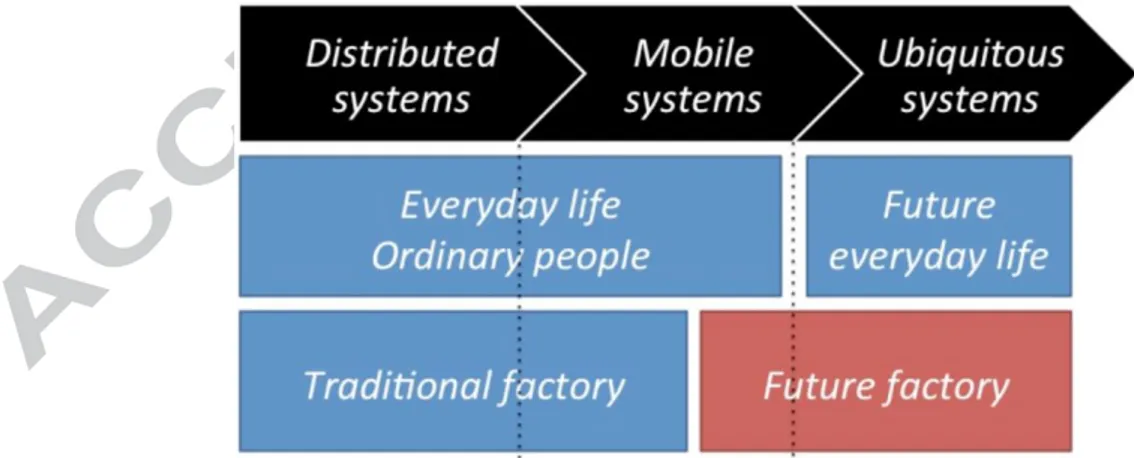
![Figure 2. Evolution of DSS: an Illustration based on [Kwon et al., 2005].](https://thumb-eu.123doks.com/thumbv2/123doknet/11647472.308007/9.892.199.799.102.448/figure-evolution-dss-illustration-based-kwon-et-al.webp)
